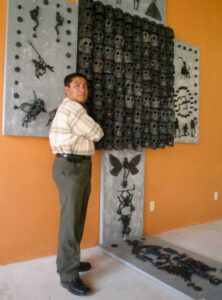
Among Oaxaca’s many notable creators, Carlomagno Pedro deserves recognition for a lifetime dedicated to breaking the barrier between handcrafts and fine art.
Pedro, born in 1965, is from the town of San Bartolo Coyotepec, made famous in the mid-20th century by Rosa Real Mateo, or Doña Rosa, as she was better known. She put the town on the map internationally, by learning to burnish the local clay to a shiny black and creating decorative objects called barro negro.
I had the pleasure of meeting him for the first time in 2016 at his workshop in Coyotepec. When I told him that my students and I had created an article about him on Wikipedia, he responded “That was you? I did not know what Wikipedia was, but my grandchildren found the article and were very impressed that I was in it.”
His early training in barro negro was traditional, although his father made (and still makes) figurines. As a child, he began to experiment with the possibilities that the clay represented, and convinced that it had potential, decided to study fine art at the Rufino Tamayo Workshop in Oaxaca city.
That training, along with his innate talent, has resulted in the interpretation of traditional themes of Oaxacan life and death in a much more nuanced way. Many of his works are skeletal figures, but these are not mere Day of the Dead decorations; they are expressions of how Pedro sees the world.
 Pedro with a skull cross mural that can be seen at the museum he directs. (Friends of Oaxacan Folk Art)
Pedro with a skull cross mural that can be seen at the museum he directs. (Friends of Oaxacan Folk Art)
But working with clay did not open doors among Mexico’s artistic elite, certainly not early on in his career. Turok met him around this time and notes that his attempts to participate in fine arts events were rejected until the highly regarded abstract artist Manuel Felguérez chastised his fellow artists for their narrow-mindedness.
In 2014, Pedro received Mexico’s highest honor for artisans, the National Arts Prize (Popular Traditions category), for his work “elevating” Zapotec and Mixtec indigenous cultures. Pedro says that winning the award vindicated all the struggles that he suffered throughout his decades as an artist.
Pedro’s contributions to Oaxacan culture do not stop with pottery. When the state decided to open a folk art museum almost 20 years ago, Coyotepec was chosen as the site and Pedro as its founding (and current) director. The Museo Estatal de Arte Popular de Oaxaca has since sponsored hundreds of exhibitions, cultural events and workshops.
 Pedro’s magnum opus, a tribute the role of baseball in modern Oaxacan culture at the Baseball Academy in the state capital. (Academia de Beisbol Alfredo Harp Helú)
Pedro’s magnum opus, a tribute the role of baseball in modern Oaxacan culture at the Baseball Academy in the state capital. (Academia de Beisbol Alfredo Harp Helú)
Turok sees Pedro’s work and legacy as invaluable to the barro negro tradition of Coyotepec.
“He portrays tradition but in a unique way, one that gives the clay a spirit, showing his fellow artisans another path, that there are many paths to develop the art form.”

 Pedro with a skull cross mural that can be seen at the museum he directs. (Friends of Oaxacan Folk Art)
Pedro with a skull cross mural that can be seen at the museum he directs. (Friends of Oaxacan Folk Art) Pedro’s magnum opus, a tribute the role of baseball in modern Oaxacan culture at the Baseball Academy in the state capital. (Academia de Beisbol Alfredo Harp Helú)
Pedro’s magnum opus, a tribute the role of baseball in modern Oaxacan culture at the Baseball Academy in the state capital. (Academia de Beisbol Alfredo Harp Helú)
Leave a Reply